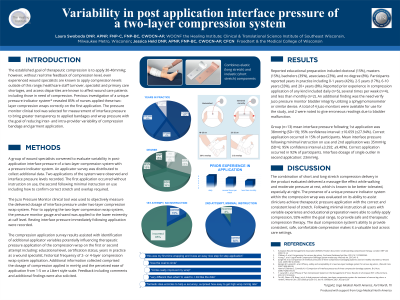Evidence-Based Practice
(EBP-010) Variability in post application interface pressure of a two-layer compression system

The established goal of therapeutic compression is to apply 30-40mmHg; however, without real time feedback of compression level, even experienced wound specialists are known to apply compression levels outside of this range. Previous investigation of a unique, patented pressure indicator system revealed 85% of nurses applied two-layer compression wraps correctly on the first application.
Methods:
A group of wound specialists convened to evaluate variability in post-application interface pressure of a two-layer compression system with a patented pressure indicator system. An applicator survey was distributed to collect additional data. Following minimal instruction on use, two applications of the two-layer compression system with the patented pressure indicator system were observed and interface pressure levels recorded.
The Juzo Pressure Monitor clinical tool was used to objectively measure the delivered dosage of interface pressure under two-layer compression wrap system. Prior to applying the two-layer compression wrap system, the pressure monitor gauge and wand was applied to the lower extremity at calf level. Resting interface pressure immediately following application were recorded.
Results:
The compression application survey results assisted with identification of additional applicator variables potentially influencing therapeutic pressure application of the compression wrap on the first or second attempt including: educational level, certification status, years in practice as a wound specialist, historical frequency of 2- or 4-layer compression wrap system application. Additional information collected comprised the dosage of compression applied in mmHg and the perceived ease of application from 1-5 on a Likert style scale. Comments and additional findings were also solicited.
Discussion:
The presence of a unique, patented pressure indicator system within the compression wrap was evaluated on its ability to assist clinicians achieve therapeutic pressure application with the correct and consistent level of stretch. The combination of short and long stretch compression delivery in the product evaluated delivers a massage-like effect while walking while also providing moderate pressure at rest, which can be better tolerated, especially at night. A dual compression system provides continuous, consistent, comfortable compression. The pressure monitor clinical tool was selected for measurement of interface pressure under garments that offer variable pressure to bring greater transparency to applied bandages and wrap pressure with the goal of reducing inter- and intra-provider variability of compression bandage and garment application when used a standardization tool.
Trademarked Items: UrgoK2 dual compression system; Juzo Pressure Monitor
References: 1. European Wound Management Association (EWMA). Position Document. Understanding compression therapy. London: MEP Ltd; 2003:13-14.
2. O'Meara S, et al. Compression for venous leg ulcers. Cochrane Database Syst Rev. 2012;14;11:CD000265.
3. Young T, et al. UrgoKTwo® Compression Bandage System made easy. Wounds Int. 2013;4:1-6.
4. Jünger M, et al. Comparison of interface pressures of three compression bandaging systems used on healthy volunteers. J Wound Care. 2009;18(11):474-80.
5. Benigni JP, Lazareth I, et al. Efficacy, safety and acceptability of a new two-layer bandage system for venous leg ulcers. J Wound Care. 2007;16(9):385-90.
6. Hanna R, Bohbot S, Connolly N. A Comparison of interface pressures of three compression bandage systems. Br J Nurs. 2008;17(20):S16-24.
7. Lazareth I., et al. Efficacy of Two Compression Systems in the Management of VLUs: Results of a European RCT. J Wound Care. 2012;21(11):553-65

.png)